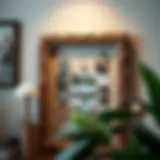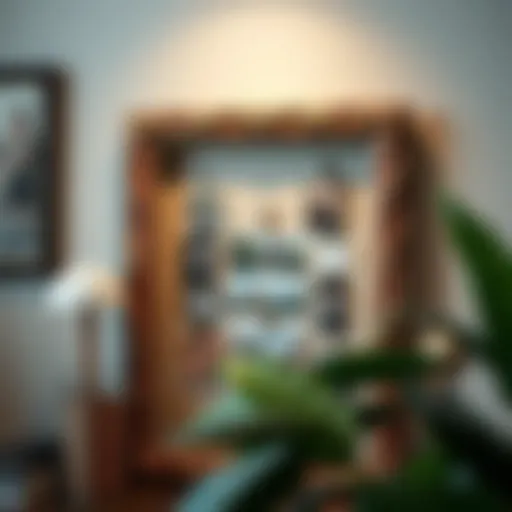Creative Bathroom Lighting Ideas for Stylish Spaces
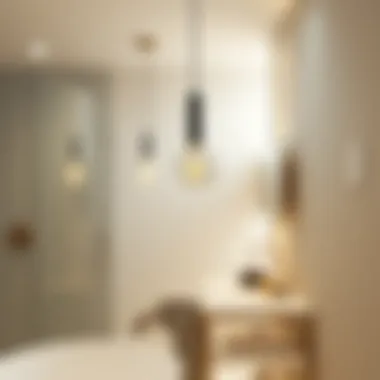
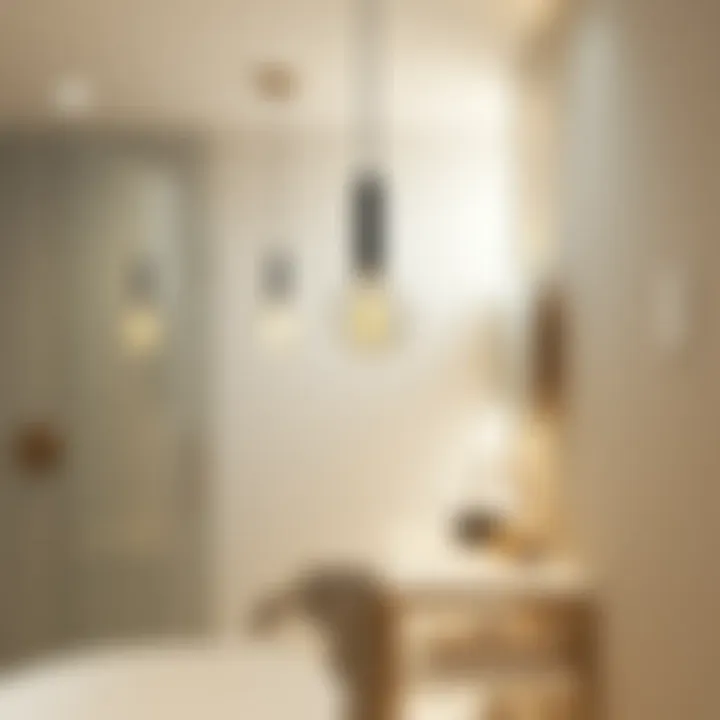
Intro
Lighting in a bathroom serves a dual purpose: it must be functional, providing adequate visibility for tasks such as shaving or applying makeup, while also contributing to the overall ambiance. In recent years, innovative bathroom lighting designs have emerged, blending both practicality and aesthetic appeal. Homeowners increasingly want their spaces to reflect personal style, transforming bathrooms into inviting sanctuaries. This article delves into the latest trends and concepts in bathroom lighting, offering insights tailored to homeowners, designers, and DIY enthusiasts alike.
Design Trends
When considering how to elevate bathroom spaces through illumination, it’s vital to explore current design trends that resonate well with contemporary aesthetics.
Current Trends in Lighting Styles
In modern bathrooms, minimalism continues to reign supreme. Sleek, streamlined fixtures have become increasingly popular, characterized by clean lines and subtle elegance. Various materials, from polished chrome to matte black, are making waves. For those who appreciate a touch of flair, decorative sconces on either side of a mirror create a warm glow, enhancing the inviting quality of the space.
Smart lighting solutions are another advancement worth noting. The ability to control brightness and color temperature via mobile apps or voice commands allows for customized experiences. Picture this: stepping into your bathroom after a long day and choosing soft, warm lighting to unwind; or bright daylight colors during the morning routine to invigorate your day.
How to Incorporate Trends into Your Space
Integrating these trends can seem daunting, but with a bit of guidance, it can be quite straightforward.
- Assess Your Space: Begin by evaluating the current structure of your bathroom. What elements do you love and what could use improvement? Taking stock will help you create a vision.
- Select Fixtures Wisely: Invest time in selecting fixtures that not only fit your style but also serve a purpose. For instance, a dimmable ceiling fixture paired with side sconces can balance functional needs with aesthetic desires.
- Play with Layering: Layered lighting can transform your bathroom into a dynamic environment. Combine ambient lighting with task lighting and decorative pieces to enhance depth and interest.
"Lighting is not just about function; it is an essential component of interior design that can dramatically influence mood and perception."
Practical Tips for Homeowners
To ensure that your lighting choices don’t just look good but also fit your practical needs, consider these key aspects:
- Consider Lumens, Not Watts: The brightness of your fixtures should align with the activities performed in the bathroom.
- Use Natural Light: If possible, incorporate natural light into your design. Sunlight streaming through the window not only brightens but enhances the room’s warmth.
- Easily Replaceable Bulbs: Choose LED bulbs for their longevity and efficiency. Some LED options even mimic the glow of traditional incandescent bulbs, providing a cozy atmosphere without the extra energy cost.
For further insights and more ideas, you can check sources like Wikipedia, Britannica, and community discussions on Reddit.
Engaging with the latest design blogs and forums can also be beneficial to tap into ongoing conversations about bathroom lighting advancements.
Understanding Bathroom Lighting
Understanding the intricacies of bathroom lighting is essential for any homeowner or designer looking to create a space that is both functional and aesthetically pleasing. Bathrooms often become a sanctuary – a place for relaxation and rejuvenation. As such, the lighting must cater to various needs, from brightening up the space for daily grooming routines to creating a serene atmosphere for unwinding after a long day. The right lighting can influence the overall mood of the room while also providing practical benefits.
The Importance of Lighting in Bathrooms
The lighting in bathrooms serves more than just a practical purpose. It's about setting the tone and transforming the space into an inviting environment. Good lighting can alter how colors appear, highlight architectural features, and even aid in preventing accidents in a room often laden with moisture and slick surfaces. Moreover, having properly lit spaces enhances safety and efficiency, especially during tasks like shaving, applying makeup, or reading.
Unforutunately, underestimating bathroom lighting can lead to poorly lit areas that impact functionality. Inadequate light can cause discomfort, frustration, and in some cases, even harm. Hence, understanding the significance of this aspect is vital when embarking on bathroom renovations or new constructions.
Different Types of Bathroom Lighting
When selecting lighting for bathrooms, it’s crucial to understand the different types available. Each type serves a unique purpose and contributes differently to the overall ambiance of the space.
Ambient Lighting
Ambient lighting is the foundation of any well-lit bathroom. Often referred to as general lighting, it fills the whole room with even illumination, creating a comfortable level of brightness throughout. This type of lighting is typically achieved through ceiling fixtures, flush mounts, or recessed lighting.
One of the key characteristics of ambient lighting is its versatility. It’s the go-to option for homeowners looking for a spatially balanced illumination that doesn’t overbear the senses. This makes it a significant choice in our discussion. The unique feature of ambient lighting lies in its ability to create a warm and welcoming atmosphere, making it ideal for a room often associated with wellness and relaxation.
"A well-lit bathroom starts with ambient lighting that provides a base for other, more specific kinds of lighting."
However, it’s important to be mindful of the drawbacks. If ambient lighting is too harsh or not well-distributed, it could lead to glaring reflections in mirrors, creating an uncomfortable environment. Thus, striking the right balance is key.
Task Lighting
Complementing ambient lighting, task lighting in bathrooms is specifically meant to illuminate areas where close-up work is done. This lighting usually comes from sources like sconces on either side of a vanity mirror or focused ceiling lights directed downwards.
The key advantage of task lighting is its effectiveness in providing targeted illumination where it’s most needed. This is of utmost importance when performing tasks like shaving or applying makeup, where precise visibility is crucial. The unique feature of task lighting is that it can be adjusted for brightness and direction, thus ensuring better user control.
Even so, there's a downside: task lighting, if poorly installed or positioned, can create unwanted shadows, making the very task it’s intended for more difficult. Therefore, thoughtful placement of these lights is essential for optimal results.
Accent Lighting
Accent lighting takes the spotlight when it comes to enhancing the unique attributes of a bathroom. Commonly used to add visual interest or highlight design elements, this type of lighting often consists of small fixtures aimed at features like artwork, architectural details, or textured walls.
The primary characteristic of accent lighting is its ability to create focal points, drawing attention to specific areas you want to showcase. It adds character and depth to a bathroom, making it a popular choice for those wanting to elevate their design aesthetic.
However, accent lighting is typically not meant to provide general illumination. If relied on exclusively, it may lead to poorly lit spaces that lack functionality. Thus, a decent balance with ambient and task lighting is advisable to preserve the overall effectiveness of the room’s design.
Evaluating Bathroom Lighting Needs
When it comes to designing a bathroom, lighting is a major character in the script. It plays a crucial role, influencing not just visibility, but also the vibe of the room. To nail down a well-lit bathroom, evaluating lighting needs is about more than just selecting a pretty fixture or two. It’s about understanding how different aspects of the space meld together seamlessly.


By starting the process right here, you set a sturdy foundation for maximizing both functionality and appeal. Ignoring this phase might lead you down the rabbit hole of mismatched bulbs and ghastly shadows. Thus, examining your space isn’t merely a task for designers; it’s a rite of passage for every homeowner.
Assessing Space and Layout
The first step in assessing lighting needs is to practically eyeball the space and layout of your bathroom. Is it tight and compact, or grand and roomy? Every nook and cranny can affect how light plays off surfaces. Sleek countertops might reflect light differently compared to textured walls. This initial assessment can guide your choice of fixtures and styles.
- Room Dimensions: Measure the height, width, and length to gauge how expansive the area feels.
- Natural Light Sources: Notice the size and position of windows. Can you utilize daylight? If you have a window up high, it brings a different feel than a low one.
- Access Points: Think about the door’s placement - it can block natural light or shift shadows in odd directions.
If you're working with less space, a wall-mounted light or recessed fixtures might do more favors than bulky overhead options. In contrast, expansive areas may welcome a layered blend of ceiling lights and accent illumination to create depth without dark corners. If your bathroom has architectural features like beams or niches, consider how to highlight these.
Identifying Usage Scenarios
Identifying usage scenarios is about getting into the nitty-gritty of how the bathroom will actually be used. This is where things get interesting!
- Functional Usage: Are you utilizing the space mainly for quick wash-ups, or is it a retreat for soaking away the stress of the day? If it's a family bathroom, bright task lighting around the mirrors makes sense. For a master bath, softer ambient lighting might help create a spa-like oasis.
- Personal Preferences: Do you enjoy reading during a bath or applying makeup with precision? These unique habits dictate the kind of light required. A simple overhead bulb won’t cut it if you're trying to finesse the perfect cat-eye.
- Seasonal Changes: The magic of seasons also plays a role. In winter, you might need brighter lighting to offset shorter daylight hours. In the summer, natural light takes center stage.
"Your bathroom is more than just a place for hygiene; it’s a canvas for relaxation and rejuvenation. Hence, understanding your usage is paramount in achieving effective lighting."
When you weave together considerations on space and user scenarios, you foster a thoughtful approach to bathroom lighting. It’s not a one-size-fits-all game. Each choice reverberates with an individual touch, imbuing the space with a personality as unique as the one who uses it.
To dive deeper into the nitty-gritty of lighting dynamics, check out resources like Wikipedia on Bathroom Lighting and Britannica. Quality lighting creates harmony—taking time to evaluate your needs will pay off in leaps and bounds.
Lighting Fixture Options
Choosing the right lighting fixtures is a cornerstone of any effective bathroom design. The right fixtures can transform a mundane space into a sanctuary of style and utility. The importance of lighting fixture options in this article cannot be overstated. These fixtures not only illuminate the space but also contribute significantly to the overall aesthetic. They come in various designs, sizes, and functionalities, allowing homeowners and designers to tailor their selections based on the specific needs of the space.
When evaluating lighting fixtures, consider elements such as functionality, style, and placement. Not every fixture works for every situation, and understanding the nuances between them can be the key to achieving optimal lighting.
Here’s a deep dive into some popular fixture choices:
Wall Sconces
Wall sconces can offer both visual appeal and practicality. Installed on walls beside mirrors or above vanities, they provide essential light where it's needed most. The primary benefit of wall sconces is that they can create a flattering glow, enhancing facial features and making grooming tasks easier.
In tighter spaces, wall sconces can also free up counter space, providing light without needing ceiling mounts. Consider choosing sconces with dimmable features for flexibility, as mood lighting can play an essential role in creating a relaxing environment.
Vanity Lights
Vanity lights are perhaps the most common fixture seen in bathrooms. Typically mounted above or alongside mirrors, these lights are designed specifically for grooming activities. Their placement is crucial; lights should be at eye level to minimize shadows.
Selecting fixtures that complement the overall bathroom decor while ensuring maximum illumination is important. Opt for bulbs that provide a warm color temperature, which can enhance the ambiance and make spaces feel inviting.
Flush Mount and Ceiling Lights
Flush mount and ceiling lights offer a practical solution, especially in spaces with low ceilings. These fixtures are mounted directly to the ceiling, making them ideal for modern bathrooms with a clean and uncluttered look.
While they provide excellent ambient lighting, consider pairing them with other types of fixtures, such as sconces or moonlight-themed chandeliers, to create layers of light. This layered approach helps in achieving the right balance between bright utility lighting and softer ambient light.
LED Strip Lighting
LED strip lights are rapidly becoming a favorite among homeowners and designers alike. They offer a modern touch and versatility in accentuating various areas of the bathroom. From illuminating shelves to outlining mirrors, LED strips can create dramatic effects.
Additionally, they are energy-efficient and have a long lifespan, making them a practical choice as well. Customizing the light color—by choosing different settings—can also influence the ambiance of the space.
"When in doubt, layer your lighting. The combination of general, task, and accent lighting brings depth and complexity to your design."
In summary, selecting the right lighting fixtures is crucial for not just aesthetics but also functionality in bathrooms. Each option serves its purpose and can drastically affect how the space feels and functions. By considering the unique characteristics and potential benefits of each fixture type, homeowners and designers can make informed choices that enhance their bathroom designs.
Creative Lighting Arrangements
When it comes to the bathroom, lighting isn't just about illumination; it’s an essential part of the overall ambiance. Creative lighting arrangements play a vital role in transforming a mundane space into something inviting and stylish. By layering different types of lighting, you can create a functional yet comfortable atmosphere. This involves a careful selection of fixtures and their placements to ensure both practical use and aesthetic appeal.
Why it Matters: Proper lighting arrangements can enhance the perception of space, improve visibility for tasks like shaving or applying makeup, and even set a mood for relaxation. With the right layout, your bathroom can feel cozy and expansive at the same time. The key elements to consider include layering light, creating focal points, and using reflective surfaces effectively.
Layering Light for Ambiance
Layering light provides depth and warmth to any bathroom. The key is to combine ambient, task, and accent lighting in a balanced way. Start with ambient lighting, which generally serves as the main source of illumination. This can be achieved through flush mounts or ceiling fixtures that spread light evenly across the room.
Next, bring in task lighting. This is particularly crucial around mirrors and vanities, where clear visibility is necessary. Options like wall sconces on either side of the mirror help eliminate shadows, making your routine more efficient and enjoyable. Lastly, incorporate accent lighting to highlight architectural features or decor items that catch the eye.
A harmonious blend of these light sources can transform your bathroom from a stark workspace into a sanctuary.
Focal Points Created with Lighting
Lighting can also serve as an art form, guiding the eye to specific elements within your bathroom. Create clear focal points by using strategically placed lights. For instance, a pendant light over a freestanding tub can draw attention and make the bathing area feel more luxurious. Spotlighting unique features such as artwork, plants, or textured walls adds intrigue and draws visitors in.
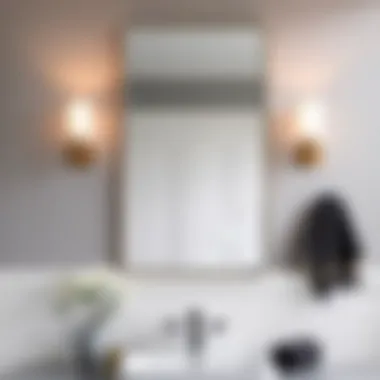
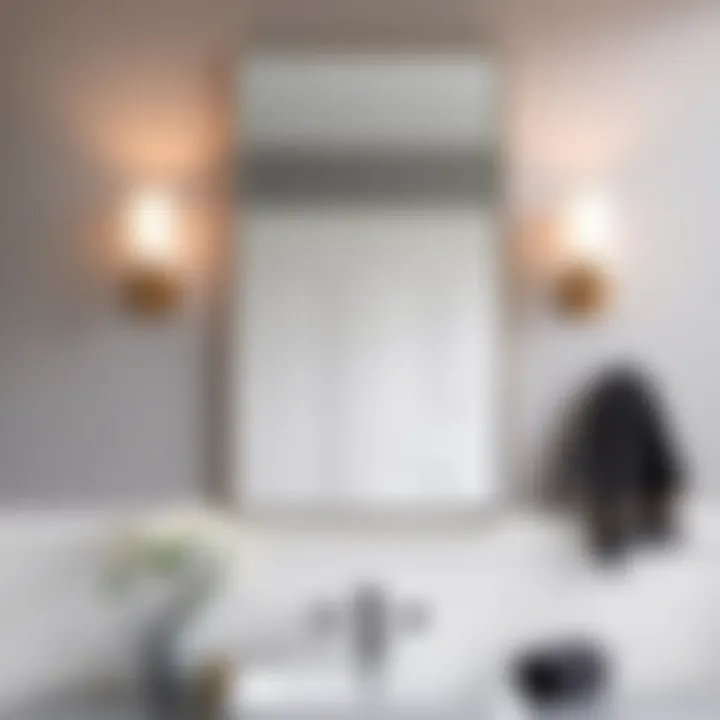
When designing these focal points, consider the contrast between light and dark spaces. Darker areas can make a room feel cozy, while light areas can create openness. Highlighting interesting textures or colors with light can turn functional spaces into visual statements. This elevates not only the look but also the feel of the entire room.
Utilizing Mirrors to Enhance Lighting Effects
Mirrors aren’t just for checking your reflection; they serve as powerful tools for enhancing lighting in a bathroom. When you position mirrors strategically, they can reflect light and amplify brightness in a space. For example, placing a large mirror across from a window can double the natural light you get during the day.
Furthermore, consider adding backlit mirrors. These not only brighten the space but provide a soft glow that can be soothing during evening routines. Using framed mirrors with decorative lights around them can also act as statement pieces, blurring the line between functionality and art.
Incorporating mirrors into your lighting design isn’t merely a practical choice; it’s a creative opportunity to redefine your bathroom’s dimensions and mood.
"Light can be that chameleon, transforming a space from mundane to magnificent just with the right arrangements."
In summary, creative lighting arrangements in bathrooms offer essential benefits: they provide comfort, improve utility, and enhance aesthetic appeal. By layering your lights, creating striking focal points, and optimally utilizing mirrors, you turn your bathroom into a beautifully lit space that impresses and serves effectively.
Incorporating Natural Light
Incorporating natural light into bathroom design is a game changer. Not only does it lighten the mood, but it can also make a space appear larger and more inviting. Natural light can serve as a transformative element, combining both functionality and visual appeal effectively. When it dances through a well-placed window or skylight, it’s not just the room that benefits; one’s spirit can be lifted too. This natural illumination offers numerous advantages, such as enhanced energy efficiency, reduction of artificial lighting needs, and a healthier environment that promotes well-being.
Considerations such as window placement, orientation, and surrounding structures play a pivotal role in determining how much natural light a bathroom can collect. Adequate exposure can diminish the reliance on electric lights during the day, thus saving electricity costs. Furthermore, it creates a soothing atmosphere, helping in relaxation, which is vital after a long day.
Maximizing Window Light
Windows can be a bathroom’s best friend. They invite sunshine in while framing the outside world like a piece of artwork. To maximize window light, it's essential to think like a designer. Here are few ideas:
- Choose the Right Placement: Positioning windows on the south or west side of the house allows for more sunlight, especially during the warmer months.
- Opt for Clear or Frosted Glass: Clear glass windows allow unimpeded light to flood in while frosted options provide privacy without entirely blocking visibility.
- Consider Window Size: Larger windows obviously let in more light. Skylights can serve as a powerful alternative if wall space for windows is limited.
Moreover, never underestimate the impact of reflective surfaces. Mirrors can bounce the natural light around the room, enhancing brightness and depth. It’s like flipping a switch, bringing instant energization into otherwise dim corners.
Using Skylights for Illumination
Skylights are a fantastic way to incorporate natural light when wall windows simply won't do. They can make your bathroom feel airy and spacious while bringing nature just a glance away. Here’s how to effectively use skylights:
- Placement Matters: Install skylights over the shower or bathtub, but ensure they are well-placed to avoid water intrusion problems.
- Use Vented Skylights: These can help regulate bathroom humidity and allow hot air to escape, preventing mold buildup.
- Select the Right Size: A larger skylight can bring more light, but it’s vital to consider the bathroom’s layout and aesthetics. A finicky balance is key, as oversized options might overwhelm a small space.
Working with natural elements not only enhances the room's ambiance but also promotes sustainability. Incorporating natural light signifies a shift from utilitarian spaces to ones that breathe and feel alive.
In sum, embracing natural light is more than just an aesthetic choice; it's a decision that enhances functionality and well-being in intimate spaces like bathrooms. By maximizing window light and strategically using skylights, homeowners and designers can craft bathrooms bathed in the beauty of nature while maintaining a balance between style and efficiency.
Choosing the Right Bulbs
When you’re revamping your bathroom lighting, it’s easy to focus on the fixtures and stylistic elements only. However, the bulbs themselves play a critical role too. Choosing the right bulbs can elevate the whole lighting experience, shaping not just the environment but also impacting functionality and energy efficiency. The way a room feels and how well it serves its purpose are largely dependent on the quality of lighting.
A bulb can influence how colors appear, how shadows fall, and how comfortable people feel in the space. With an array of options available, understanding what to look for becomes essential. Here are some key aspects to consider when selecting bulbs for your bathroom:
- Brightness: Measured in lumens, this tells you how much light a bulb produces. Ideally, you want enough light to brighten up the space, particularly over work areas like vanities.
- Color Temperature: This element is crucial for creating the right mood. A cooler light creates a refreshing, clean feel, while a warmer light tends to be more relaxing and cozy.
- Energy Efficiency: Selecting energy-efficient options can lead to noticeable savings on your utility bill, while also reducing your environmental footprint.
By considering these factors thoughtfully, homeowners and designers can ensure they select bulbs that serve their intended purpose effectively while enhancing the overall aesthetic of the bathroom.
Decorative Lighting Styles
Decorative lighting styles play a crucial role in shaping the overall atmosphere of a bathroom. While task and ambient lighting are vital for functionality, decorative fixtures add character and personal flair to a space. Incorporating unique designs not only enhances aesthetics but also contributes to an inviting environment. Choosing the right decorative lighting can transform a mundane bathroom into a stunning retreat, reflecting the homeowner's personality and style preferences.
Modern and Minimalist Designs
In the world of bathroom decor, modern and minimalist designs have gained substantial popularity. Characterized by clean lines and a clutter-free approach, these styles emphasize simplicity without sacrificing elegance. Fixtures often feature geometric shapes, smooth surfaces, and a neutral color palette, focusing on materials like brushed nickel or matte black. The beauty of modern lighting is its ability to blend seamlessly with any bathroom layout, be it large or compact.
One example can be seen in sleek wall-mounted fixtures, which not only provide essential illumination but also act as stylish accents. Integrated LED lighting strips under vanities can enhance this effect, casting a soft glow that creates an illusion of space. For homeowners wanting a polished, contemporary look, consider:
- Wall sconces with geometric shades
- Pendant lights with simple contours
- Recessed lighting for a streamlined appearance
Vintage and Retro Fixtures
Stepping back in time, vintage and retro fixtures bring an air of nostalgia and warmth to bathrooms. These styles often hail from different decades, showcasing intricate designs that celebrate craftsmanship. Whether it’s the ornate details of Victorian lamps or the bold colors and patterns of mid-century designs, these fixtures add personality and charm.
By including vintage pieces, a bathroom can evoke memories of yesteryears while also serving practical needs. Here are some popular elements:
- Chandelier-style light fixtures for a luxurious feel
- Edison bulbs in exposed designs for an industrial twist
- Antique mirrors with embedded lights that reflect classic elegance
Integrating a few choice vintage fixtures amidst modern elements can create an interesting juxtaposition, providing a unique take on bathroom decor.
Industrial and Urban Inspirations
For those drawn to raw and edgy aesthetics, industrial and urban inspirations are an excellent fit for bathroom lighting. This style embraces imperfections and highlights materials like metals and exposed plumbing. Fixtures with a utilitarian feel come into play, featuring unfinished woods, steel frames, and even elements salvaged from warehouses.
Key characteristics of industrial lighting include:

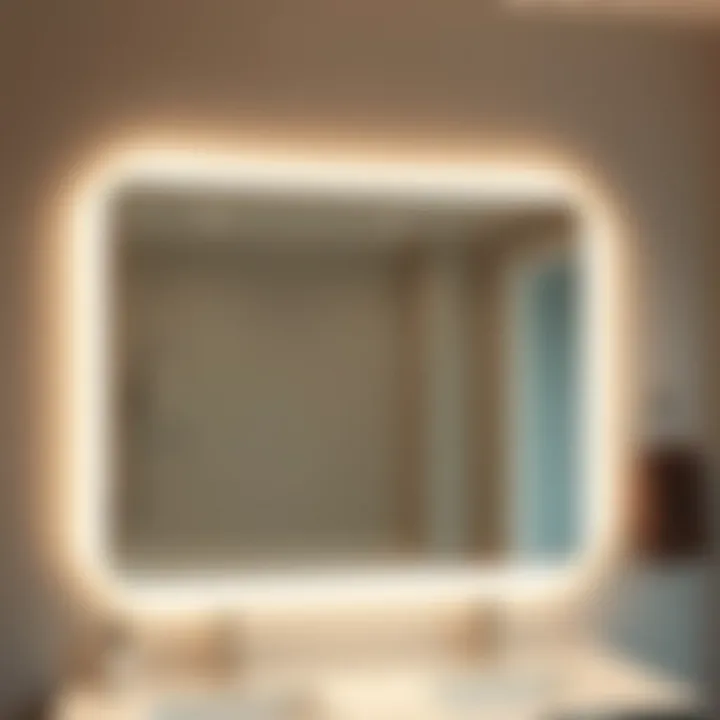
- Pendant lights with wire or cage designs that expose the bulb
- Wall lights made from repurposed materials for a touch of sustainability
- Track lighting that offers flexibility in directing illumination
Using industrial elements can tie in with a contemporary decor theme while showcasing a distinct personality. This approach also resonates well in open-concept bathroom spaces, where lighting plays a pivotal role in defining different areas.
"Vintage and retro signs should drive conversations, while minimalism ensures the bathroom remains a respite from the hustle."
In summary, decorative lighting styles add layers of depth and intrigue to bathroom design. By exploring modern, vintage, and industrial options, homeowners and designers can craft a space that is not only functional but also exceptionally stylish.
Bathroom Lighting Safety Considerations
Safety in bathroom lighting is not just about aesthetics; it’s a critical aspect that can’t be overlooked. When dealing with electrical installations in a wet environment, the risks are many, and the proper safety measures can mean the difference between a glamorous setup and a potential disaster. Homeowners, designers, and DIY enthusiasts must grasp the safety guidelines to prevent any mishaps.
Understanding Bathroom Zoning
In bathrooms, the concept of zoning refers to the division of the space into different areas based on moisture and electrical safety standards. Typically, there are three zones:
- Zone 0: This area is inside the bathtub or shower, where the highest level of water exposure occurs. Any lighting used here must be completely waterproof and suitable for submersion.
- Zone 1: This encompasses the area above the bathtub or shower up to a height of 2.25 meters. Fixtures in this zone must also be rated for water exposure but can present slightly less stringent requirements than those in Zone 0.
- Zone 2: This zone is a perimeter of 0.6 meters around Zone 1, extending horizontally. Lights in this area need to be splash-proof but not necessarily waterproof.
Understanding these zones helps in making informed decisions about placement and types of fixtures. When selecting lights for these areas, compliance with local regulations ensures not only safety but also peace of mind. The installation of electrical systems in accordance with the recommended zoning can protect against hazards, such as shock or fire. Always consult a professional when you're unsure about the specific requirements.
Choosing IP Rated Fixtures
International Protection (IP) ratings are a system for classifying the degree of protection provided by enclosures against the intrusion of foreign bodies and moisture. When selecting fixtures for a bathroom, these ratings guide you in ensuring that your lights can withstand the challenging conditions present in wet areas.
- IP44: Splash-proof—good for Zone 2, these lights can handle minor water exposure.
- IP67: Dust-tight and protected against immersion in water; perfect for Zone 0 if you want a reliable choice.
- IP65: Suitable for damp areas; these fixtures are resistant to water jets and can be utilized in Zone 1 safely.
Using IP-rated fixtures is more than a mere precaution; it’s a requirement for safety in the bathroom environment. An inappropriate choice can lead to fixture failure or worse, posing danger to users. Always verify that the fixtures meet the necessary IP rating for the specific zones they will inhabit.
Lighting in bathrooms is about more than just illumination; it’s about ensuring a safe environment where design meets functionality without compromise.
Case Studies: Successful Bathroom Lighting
Examining successful bathroom lighting examples provides invaluable insights for homeowners and designers alike. Case studies allow one to observe the effective application of lighting principles in real-world scenarios. They showcase not just the aesthetic potential of lighting, but also its functionality, addressing specific needs in different bathroom settings.
By analyzing the various elements in these case studies, we can observe trends, learn from failures, and gather ideas that might inspire our own designs. Success in bathroom lighting isn't only about illumination; it's about creating an atmosphere that complements personal style and daily routines.
Modern Inspirations from Contemporary Bathrooms
In contemporary designs, we often see a combination of sleek lines and modern materials. For instance, a recent project featured in Dwell Magazine highlights a compact bathroom where LED strips are embedded in the cabinetry. This not only makes the space feel open but also—thanks to adjustable brightness—allows for different moods. The elegant use of recessed lighting also draws the eye upwards, creating an illusion of height.
The place was filled with natural elements, like wooden accents which softened the modern edges. A glass shower enclosed by frameless walls allowed the light to bounce around, making the entire area feel expansive.
Key Takeaways:
- Layering is critical: Ambient, task, and accent lighting work together to enhance space.
- Materials matter: Reflective surfaces expand light and can brighten dark corners without heavy fixtures.
- Flexibility: Equipment like dimmers and multi-functional bulbs can change the bathroom's mood at a whim.
Classic Designs that Stand the Test of Time
Turning to more classical styles, one can look at a recent remodel showcased in Traditional Home. This bathroom highlighted the timeless appeal of vintage sconces paired alongside a double vanity. Ornate details in the fixtures complemented the traditional moldings throughout the room. Here, the use of warm-toned Edison bulbs offered a soft glow, ideal for evening relaxation.
A centerpiece that stole the show was an antique chandelier, though it was strategically placed to not interfere with headroom over the sink areas. Despite its grandeur, the light offered functionality for tasks like grooming while adding a touch of elegance.
In this case, the design was not just about lighting but creating a seamless blend of history with modern demands within the space—an approach that prompts deeper contemplation of what we value in our living environments.
Considerations for Timeless Lighting:
- Stateliness: Combining old-world artefacts with modern enhancements can yield a sophisticated look.
- Scale: Choosing the right size fixtures for the space ensures harmony without overcrowding.
- Color warmth: A balance between soft and invigorating hues can genuinely improve the bathroom experience.
Overall, these case studies illustrate how a well-conceived lighting plan can transform a bathroom. By learning from both modern and classic approaches, designers and homeowners can craft spaces that are both functional and appealing. The importance of thoughtful lighting design cannot be understated, as it significantly impacts both the aesthetics and the utility of the space.
Final Thoughts on Bathroom Lighting
In the realm of home design, bathroom lighting often takes a backseat, overshadowed by vibrant living rooms or cozy bedrooms. Yet, it plays an essential role in transforming a functional space into a serene retreat. Getting the lighting just right not only improves visibility but also enhances the overall ambiance of the bathroom. A well-lit bathroom fosters a sense of comfort and relaxation, which is vital at the start or end of a busy day.
Balancing Function and Aesthetics
Achieving the right balance between function and aesthetics in bathroom lighting is paramount. Homeowners must ask themselves: What do I need this space to do? Whether the goal is to create a spa-like haven or simply meet daily grooming tasks, the lighting should reflect that purpose.
Here are a few considerations to achieve this balance:
- Layered Lighting: Mixing ambient, task, and accent lighting helps create a well-rounded approach. For example, overhead lighting provides general illumination, while sconces beside the mirror serve the dual purpose of function and decoration.
- Choosing the Right Fixtures: Selecting fixtures that resonate with the bathroom's overall style can harmonize the design without compromising on function. A sleek, modern fixture can shed plenty of light, while ornate sconces may add a touch of elegance.
- Consideration of Space: A small bathroom might be better suited for minimalistic and bright lighting, whereas a larger one can explore more theatrical choices without it feeling overwhelming.
Ultimately, the goal is to cater to both the practical needs of use and the desire for beauty. The result should reflect both who you are and how you wish to feel when you enter the space.
Future Trends in Bathroom Lighting
As we move forward, bathroom lighting is poised to embrace several exciting trends. Technology continues to redefine the way we illuminate our homes. Here’s a snapshot of what might be on the horizon:
- Smart Lighting: From app-controlled dimmers to voice-activated systems, smart lighting options are becoming increasingly mainstream. Imagine controlling the ambiance of your bathroom with a simple voice command or a touch on your smartphone.
- Sustainable Practices: Eco-friendly lighting solutions are gaining traction. LED fixtures with low energy consumption are not just good for the environment; they also save on the electricity bill in the long run.
- Customizable Scenes: People are moving toward personalized lighting scenes—setting different moods for soaking in the tub versus getting ready for work. With customizable settings, homeowners can have more control over their environment.
- Biophilic Design: Incorporating elements of nature into bathroom lighting can enhance the sense of well-being. Using fixtures that mimic natural light or adding plants that thrive in humidity can foster a more connected and soothing atmosphere.
"The future of bathroom lighting blends functionality with innovation, paving the way for a more personalized and environmentally friendly home."
By keeping an eye on these emerging trends, homeowners and designers alike can stay ahead of the curve, ensuring that their bathrooms aren't just functional spaces, but sanctuaries of comfort and style.




